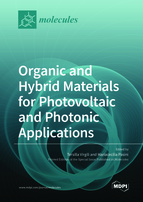Organic and Hybrid Materials for Photovoltaic and Photonic Applications
A special issue of Molecules (ISSN 1420-3049). This special issue belongs to the section "Applied Chemistry".
Deadline for manuscript submissions: closed (31 May 2022) | Viewed by 28720
Special Issue Editors
Interests: ultrafast spectroscopy; organic and hybrid material; strong and weak coupling
Special Issues, Collections and Topics in MDPI journals
Interests: development of organic and hybrid materials for optoelectronic and photonic; nanomaterials; sustainable materials and processes for advanced applications
Special Issues, Collections and Topics in MDPI journals
Special Issue Information
Dear Colleagues,
Today, there is a huge demand for advanced materials capable of providing technological innovations. Among these, “organic semiconductors” combine the progress of semiconductors and plastic of the last century, becoming the subject of intense industrial and academic research. More recently, organic–inorganic hybrid functional materials have became a potential platform for applications in extremely diverse fields such as optics, microelectronics, transportation, health, energy, and energy storage. The interest in them is explained by the fact that it is possible to combine the best characteristics of both components in a large variety of combinations; in this way, they represent an intriguing class of materials with a large spectrum of applications.
This Special Issue will consider recent developments in the field of organic and hybrid materials in two of the most useful and promising applications of the millennium: photovoltaics and photonics. Multiple aspects of the materials will be taken into consideration, from the synthesis and the photophysical characterization to the application.
Dr. Tersilla Virgili
Dr. Mariacecilia Pasini
Guest Editors
Manuscript Submission Information
Manuscripts should be submitted online at www.mdpi.com by registering and logging in to this website. Once you are registered, click here to go to the submission form. Manuscripts can be submitted until the deadline. All submissions that pass pre-check are peer-reviewed. Accepted papers will be published continuously in the journal (as soon as accepted) and will be listed together on the special issue website. Research articles, review articles as well as short communications are invited. For planned papers, a title and short abstract (about 100 words) can be sent to the Editorial Office for announcement on this website.
Submitted manuscripts should not have been published previously, nor be under consideration for publication elsewhere (except conference proceedings papers). All manuscripts are thoroughly refereed through a single-blind peer-review process. A guide for authors and other relevant information for submission of manuscripts is available on the Instructions for Authors page. Molecules is an international peer-reviewed open access semimonthly journal published by MDPI.
Please visit the Instructions for Authors page before submitting a manuscript. The Article Processing Charge (APC) for publication in this open access journal is 2700 CHF (Swiss Francs). Submitted papers should be well formatted and use good English. Authors may use MDPI's English editing service prior to publication or during author revisions.
Keywords
- Novel organic and hybrid materials
- Interlayer materials for photovoltaic devices
- Sustainable materials, approaches, and methods
- CW and ultrafast photophysical characterization
- Perovskite semiconductors
- Organic and hybrid nanoparticles
- New lasing materials
- Strong coupling or weak coupling regime in organic and hybrid microcavities
- Amplified spontaneous emission.








